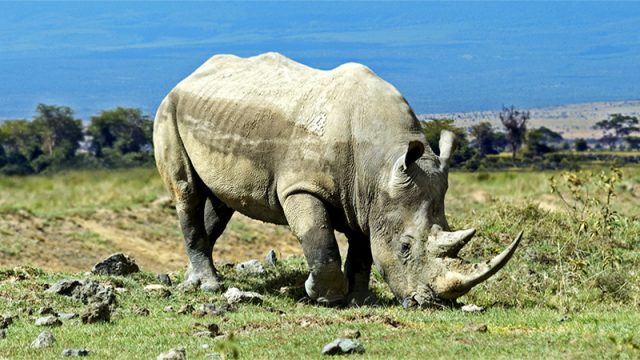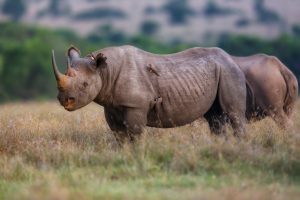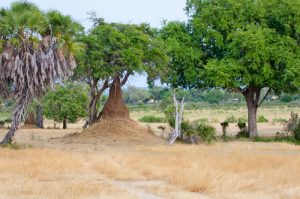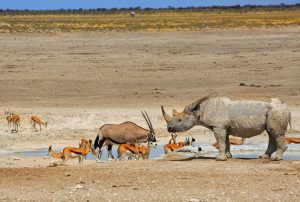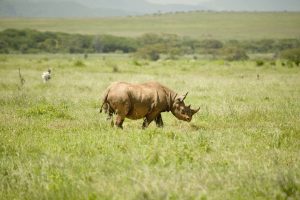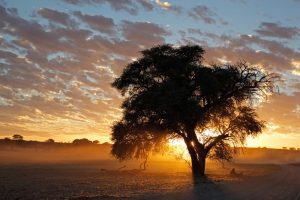While black rhinos in Africa once numbered over 100,000, their population is now around 5,000, making them critically endangered. Black rhinos are generally most active during the night-time when they forage and drink, making them harder to spot than other animals. They are also solitary, and are known for being shyer and more aggressive than white rhinos. Their habitat is mainly throughout southern and eastern Africa, but to spot them, you have to know where to go. Here are some of the places where you can still see black rhinos in Africa.
Ol Pejeta Conservancy, Kenya
Covering over 90,000 acres, this not-for-profit wildlife conservancy in Nanyuki, Kenya has the largest and fastest growing population of rhinos in Africa. It boasts 80 black rhinos, along with the last male northern white rhino in the world. Early morning game drives are the best time to see the rhinos, and they aren’t difficult to find at all. But if you do happen to miss them on your safari, you can still go and help feed Baraka, a blind rhino that is kept in an enclosure as an ambassador to the park. If you’re in East Africa, it’s your best bet for seeing the majestic beasts.
Damaraland, Namibia
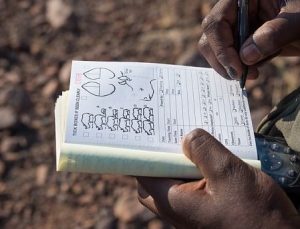
Courtesy of wilderness-safaris.com
Damaraland is home to the largest free-roaming population of black rhinos in Africa, although the vast area makes them somewhat hard to spot. Rhinos are best located in the 450,000 Palmwag Concession, where they have adapted to the desert environment. The rhinos in the park are protected by Save the Rhino Trust, an organization that was started two decades ago by Namibian citizens to guard what was left of the vulnerable rhino population in southern Africa.
Selous Game Reserve, Tanzania
Like Ol Pejeta, Selous is home to one of the largest populations of black rhino in east Africa. It isn’t visited as much as the Serengeti, but it is four times the size. Rhino populations are currently increasing in the park, despite decades of poaching that drastically reduced their numbers. Only 10% of the park is open for tourism, while the rest is reserved for hunting and research. Not many travelers make it down to Selous due to its remote location, but those that do are in for a treat.
Etosha National Park, Namibia
Etosha is one of the best overall game parks in Africa — and not just for spotting rhino. While you’ll occasionally see a rhino on a game drive, it’s best to see them after dark when they go to the waterholes next to the Okaukuejo and Halali rest camps. The best time to visit is in the dry months where you have a chance of seeing dozens of rhinos on a safari. Despite a dwindling black rhino population across the continent, numbers in Etosha are actually increasing. You can even find rhinos in the wilder western portion of the park, where breeding programs have led to increased sightings.
Lewa Wildlife Conservancy, Kenya
Lewa has one of the best rhino conservation programs in Africa and is home to populations of both black and white rhinos. The park currently has a population of 66 black rhinos and 62 white rhinos. You might also spot Prince William, who has been known to visit. The park started with 15 black rhinos in 1984 and is continually adding more. The conservancy is also quite large, covering 93,000 acres of prime habitat for the black rhinos. Borana Conservancy has also recently teamed up with Lewa to remove the fence separating the two areas and create one large landscape for the rhinos to thrive in.
Southern Kalahari, South Africa
Also known as the “green Kalahari,” the southern Kalahari, located in South African’s Northern Cape is known for supporting a broad diversity of wildlife that have adapted to the semi-arid grassland. Within this area, the Tswalu Kalahari Private Reserve is home to around one third of South Africa’s entire black rhino population. Rhinos in the reserve are protected by the conservation team and are identified by notches in their ears and microchips under their skin and horns. Along with black rhinos, you can also see other rare species in the area, such as pangolins and meerkats.
